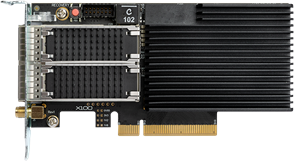Cisco Nexus K3P-Q FPGA SmartNIC Data Sheet
Available Languages
Bias-Free Language
The documentation set for this product strives to use bias-free language. For the purposes of this documentation set, bias-free is defined as language that does not imply discrimination based on age, disability, gender, racial identity, ethnic identity, sexual orientation, socioeconomic status, and intersectionality. Exceptions may be present in the documentation due to language that is hardcoded in the user interfaces of the product software, language used based on RFP documentation, or language that is used by a referenced third-party product. Learn more about how Cisco is using Inclusive Language.
High-density, ultra-low latency network interface card
The Cisco Nexus K3P-Q FPGA SmartNIC is a high-density SmartNIC, specifically optimized for low latency operation.
Features 2x QSFP28 ports that can be deployed in a high-density 8-channel configuration and software trigger-to-response latencies as low as 596ns. This is up to 20 percent faster than previous Cisco Nexus SmartNIC models, making it one of the fastest high-density network adapters in the market. Users will find that this drop-in replacement SmartNIC accelerates tick-to-trade performance to previously unachievable speeds, increasing the efficiency and profitability of software-based trading systems.
Advanced software programmability
The Cisco Nexus K3P-Q FPGA SmartNIC provides the most powerful programmable software interface on the market.
Programmability features include:
● Zero-latency cost hardware flow steering: allowing traffic filtering and steering to the right memory and CPU core with no latency penalty.
● Cut-through receive: Allows software to process packet fragments as they arrive from the wire, while packet tails are still in flight. Especially effective for slow line speeds (for example, 1GbE). The Cisco Nexus K3P-Q FPGA SmartNIC software API puts users well ahead of traditional store-and-forward SmartNIC designs to make better decisions faster.
● ExaSOCK TCP/IP acceleration: Unmodified socket applications benefit from the speed and power of the Cisco Nexus K3P-Q FPGA SmartNIC using ExaSOCK’s in-place TCP/IP socket acceleration system. ExaSOCK’s Extension API allows it to seamlessly interoperate with the Nexus K3P-Q SmartNIC’s transmit preloading feature, as described below.
● Preloaded packet transmit: The Cisco Nexus K3P-Q FPGA SmartNIC allows users to preload transmit frames, saving 60ns from the transmit path. The Cisco Nexus K3P-Q FPGA SmartNIC features enlarged packet transmit buffers allowing many more frames to be preloaded, leading to more versatile transmission choices.
● High-resolution timestamps: Four-nanosecond timestamps are applied to every received packet and the most recently transmitted packet. The Cisco Nexus K3P-Q FPGA SmartNIC also features out of the box support for IEEE1588 (PTP) and high-speed capture to disk using free and open-source Exact-Capture software.
25GbE4 ready
The Cisco Nexus K3P-Q FPGA SmartNIC is a pure FPGA-based network adapter that is 25GbE ready.
FPGA (Field Programmable Gare Array) design extends the useful life of the Cisco Nexus K3P-Q FPGA SmartNIC by allowing new features and speed enhancements to be downloaded into the adapter after deployment. For example, the Cisco Nexus K3P-Q FPGA SmartNIC will support additional Ethernet speeds through a firmware update. This will reduce capital expenditure on lengthy and difficult infrastructure upgrades.
The Cisco Nexus K3P-Q FPGA SmartNIC is built using the latest generation Xilinx UltraScale+ FPGA
The SmartNIC optionally ships with 9GB of DDR4 memory for custom applications, and it is a compact low-profile form-factor adapter. The all-FPGA design allows the user to offload critical network processing functions directly into the SmartNIC, while maintaining the ease of use and administration of a production-grade network adapter.

Cisco Nexus K3P-Q FPGA SmartNIC
Performance
Typical latency, raw frames:1
● 64 bytes: 714 ns
● 256 bytes: 927 ns
Typical latency, raw frames with preloaded TX buffer:1
● 64 bytes: 653 ns
● 256 bytes: 690 ns
Typical latency, UDP:2
● 14 bytes: 828 ns
● 256 bytes: 1.11 µs
Typical latency, TCP:2
● 14 bytes: 869 ns
● 256 bytes: 1.13 µs
Timestamping
Timestamp resolution:
● 4ns
Timestamp availability:
● All received frames, most recently transmitted frame
Time synchronization:
● Host, hardware assisted PTP, optional PPS
PPS input/output:
● 3.3V CMOS, selectable 50ohm termination
Other features
Capture:
● Line-rate capture to disk
Flow steering:
● 256 IP rules per port
● 64 MAC rules per port
FPGA Development Kit:
● Add custom user logic to FPGA
● Fully integrated with drivers and utilities
● Xilinx Ultrascale+ XCKU3P-2
● 9GB DDR4 (optional)
General
● Low-profile PCI Express Card
● 117x68mm (4.65x2.67in)
● Operating temperature: 0 °C to 55 °C
● Storage temperature: -40 °C to 70 °C
● Operating Relative Humidity: 5% to 90% (non-condensing)
● Storage Relative Humidity: 5% to 95% (non-condensing)
Recovery:
● Manual firmware recovery button
Ports:
● 2x QSFP28
● SMA for PPS in/out
Data rates:
● 40GbE, 25GbE3, 10GbE, 1GbE, 100M Fast Ethernet
Supported media:
● Fiber (40/100GBASE-SR4, 40/100GBASE-LR4), QSFP(+/28) Direct Attach
Host interface:
● PCIe x8 Gen 3 @ 8.0 GT/s per lane
Operating systems:
● Linux x86_64 (all distributions)
Information about Cisco’s environmental, social, and governance (ESG) initiatives and performance is provided in Cisco’s CSR and sustainability reporting.
Table 1. Cisco environmental sustainability information
| Sustainability topic |
Reference |
|
| General |
Information on product-material-content laws and regulations |
|
| Information on electronic waste laws and regulations, including our products, batteries, and packaging |
||
| Information on product takeback and reuse program |
||
| Sustainability inquiries |
Contact: csr_inquiries@cisco.com |
|
| Environmental |
||
| Material |
Product packaging weight and materials |
Contact: environment@cisco.com |
| Form factor |
||
Flexible payment solutions to help you achieve your objectives
Cisco Capital® makes it easier to get the right technology to achieve your objectives, enable business transformation and help you stay competitive. We can help you reduce the total cost of ownership, conserve capital, and accelerate growth. In more than 100 countries, our flexible payment solutions can help you acquire hardware, software, services and complementary third-party equipment in easy, predictable payments. Learn more.
Footnote